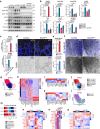Eph-ephrin signaling couples endothelial cell sorting and arterial specification
- PMID: 38570531
- PMCID: PMC10991410
- DOI: 10.1038/s41467-024-46300-0
Eph-ephrin signaling couples endothelial cell sorting and arterial specification
Abstract
Cell segregation allows the compartmentalization of cells with similar fates during morphogenesis, which can be enhanced by cell fate plasticity in response to local molecular and biomechanical cues. Endothelial tip cells in the growing retina, which lead vessel sprouts, give rise to arterial endothelial cells and thereby mediate arterial growth. Here, we have combined cell type-specific and inducible mouse genetics, flow experiments in vitro, single-cell RNA sequencing and biochemistry to show that the balance between ephrin-B2 and its receptor EphB4 is critical for arterial specification, cell sorting and arteriovenous patterning. At the molecular level, elevated ephrin-B2 function after loss of EphB4 enhances signaling responses by the Notch pathway, VEGF and the transcription factor Dach1, which is influenced by endothelial shear stress. Our findings reveal how Eph-ephrin interactions integrate cell segregation and arteriovenous specification in the vasculature, which has potential relevance for human vascular malformations caused by EPHB4 mutations.
© 2024. The Author(s).
Conflict of interest statement
The authors declare no competing interests.
Figures










Similar articles
-
Ephrin B2 and EphB4 selectively mark arterial and venous vessels in cerebral arteriovenous malformation.J Int Med Res. 2014 Apr;42(2):405-15. doi: 10.1177/0300060513478091. Epub 2014 Feb 11. J Int Med Res. 2014. PMID: 24517927
-
Divergent Roles of Ephrin-B2/EphB4 Guidance System in Pulmonary Hypertension.Hypertension. 2023 Feb;80(2):e17-e28. doi: 10.1161/HYPERTENSIONAHA.122.19479. Epub 2022 Dec 15. Hypertension. 2023. PMID: 36519465
-
Regulation of signaling interactions and receptor endocytosis in growing blood vessels.Cell Adh Migr. 2014;8(4):366-77. doi: 10.4161/19336918.2014.970010. Cell Adh Migr. 2014. PMID: 25482636 Free PMC article. Review.
-
Artery and vein size is balanced by Notch and ephrin B2/EphB4 during angiogenesis.Development. 2008 Nov;135(22):3755-64. doi: 10.1242/dev.022475. Development. 2008. PMID: 18952909 Free PMC article.
-
Molecular identity of arteries, veins, and lymphatics.J Vasc Surg. 2019 Jan;69(1):253-262. doi: 10.1016/j.jvs.2018.06.195. Epub 2018 Aug 25. J Vasc Surg. 2019. PMID: 30154011 Free PMC article. Review.
Cited by
-
Targeting endothelial MYC using siRNA or miR-218 nanoparticles sensitizes chemo- and immuno-therapies by recapitulating the Notch activation-induced tumor vessel normalization.Theranostics. 2025 Apr 13;15(11):5381-5401. doi: 10.7150/thno.112023. eCollection 2025. Theranostics. 2025. PMID: 40303332 Free PMC article.
-
Simultaneous isolation and culture of endothelial colony-forming cells, endothelial cells and vascular smooth muscle cells from human umbilical cords.Mol Biol Rep. 2025 Mar 13;52(1):302. doi: 10.1007/s11033-025-10418-1. Mol Biol Rep. 2025. PMID: 40080230 Free PMC article.
-
Evaluating the transcriptional regulators of arterial gene expression via a catalogue of characterized arterial enhancers.Elife. 2025 Jan 17;14:e102440. doi: 10.7554/eLife.102440. Elife. 2025. PMID: 39819837 Free PMC article.
-
Changes in vascular identity during vascular remodeling.JVS Vasc Sci. 2025 Feb 25;6:100282. doi: 10.1016/j.jvssci.2025.100282. eCollection 2025. JVS Vasc Sci. 2025. PMID: 40213096 Free PMC article.
-
Proteomic profiling of small extracellular vesicles from bovine nucleus pulposus cells.PLoS One. 2025 May 29;20(5):e0324179. doi: 10.1371/journal.pone.0324179. eCollection 2025. PLoS One. 2025. PMID: 40440285 Free PMC article.
References
MeSH terms
Substances
Grants and funding
LinkOut - more resources
Full Text Sources
Molecular Biology Databases
Research Materials
Miscellaneous

